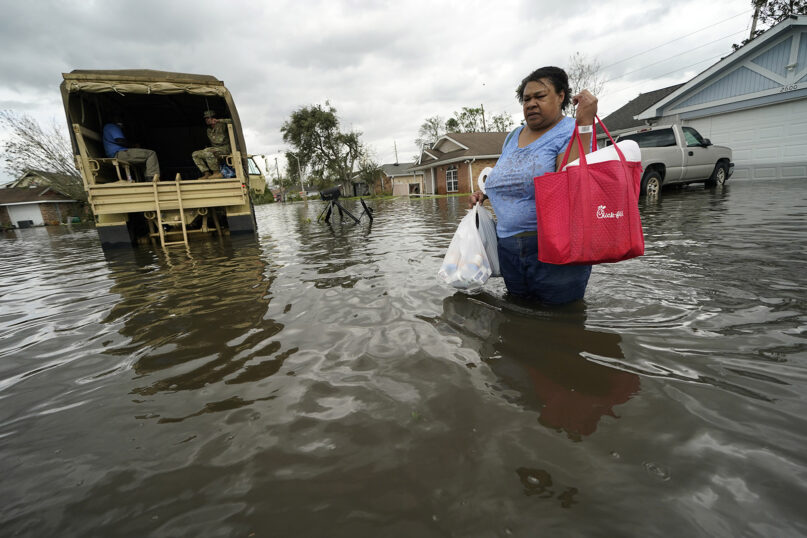(RNS) — Hurricane Ida has devastated communities in Louisiana, leaving many without electricity during one of the hottest months of the year. Because of a lack of resources or reliable transportation, many people have not been able to evacuate the region, even as their current environment remains uninhabitable.
It is not uncommon for disaster management plans to assume people have middle- or upper-middle-class assets like a private vehicle when evacuating natural disasters. But it is difficult to evacuate when one lives in poverty, lacks reliable transportation, is a primary caretaker for children and the elderly and lacks credit cards with sizable credit lines.
The fact is that much of Ida’s impact will fall on women, especially women living in poverty and women of color. This was the reality for the disproportionate number of Black women who were impacted by Hurricane Katrina, and it is the reality for Black women, Native women and others in Louisiana today. It is true of nearly all of the increased disruptions — heat waves, fire weather, droughts, tropical cyclones, extreme rainfall and coastal flooding — of climate change.
RELATED: Protecting the climate is loving our neighbor
It is time for advocates to be more vocal about the effect of the climate crisis on women, especially women living in poverty and women of color in the United States. For organizations that place women’s and children’s needs at the center of their advocacy, this issue is of utmost importance.
The United Nations estimates that 80% of those being displaced by climate are women. Everything from sexism to economic insecurity to cultural forces combine to place an undue burden of the climate crisis on women.
There are several reasons the climate crisis adversely impacts women, not the least of these being poverty. The United Nations notes that of the 1.3 billion people living in poverty, 70% are women. In urban areas, women head 40% of the lowest-wealth households. Women experiencing financial lack also tend to work more to secure their families and households. That leaves little time for their own professional development, training and education.
Persons living in poverty also tend to live in frontline communities that suffer the most from our world’s reliance on fossil fuels. They may be least responsible for the climate crisis, but they pay a hefty price.
In a reported piece, New York Times writer Lauren Jackson interviewed Dr. Katherine Wilkinson, co-editor of “All We Can Save,” and concludes that “men have a larger carbon footprint than women, by 16%, according to one study … Yet it is women and girls who bear the burdens in the wake of more frequent climate disasters. Those burdens include displacement — 80% of people displaced by climate change are women — as well as increased homelessness, poverty, sexual violence and disease.”
Women can also experience health challenges associated with climate change. Pregnant women endure heightened health risks due to inaction on climate change, including reduced access to maternal health services. Women who live close to areas where fracking occurs can also have difficulty getting or staying pregnant. Should they carry children to term, their babies may also experience birth defects and complications arising from the fumes associated with fracking.
Next, women predominate in the world’s food production (50% to 80%) but own less than 10% of the land. Not enough women are reaping the benefits of ownership or having sufficient opportunity to determine which environmental approaches to select. Women also make up 43% of the agricultural labor force in economically developing countries, which can be unstable when the worst effects of climate change kick in.
Even then, 90% of countries have laws that limit women’s economic opportunities, barring women from working at factories or getting jobs without their husband’s permission.
Relatedly, on average, women also have less access to capital globally, and in the United States that is exacerbated for women of color. Organizations led by women are also less likely to be well-funded, and organizations led by women of color face even steeper funding hurdles. This is collective failure demanding collective action.
Finally, when natural disasters hit, women globally are more vulnerable to gender-based violence, and afterwards there has been as much as a 20-30% increase in trafficking.
RELATED: COVID-19, global warming and diminishing Catholic guilt
As a faith-based women’s organization, we continue the tradition of prophets and saints of crying out for justice and, in our context today, decry the unjust impact of climate change on women, especially for women from countries and communities least responsible for the crisis. Women’s voices must be included in decision-making and solutions.
Our efforts to address climate change must also address gender inequity. Until we do, we will never level the playing field enough to protect women.
(Elizabeth Chun Hye Lee is the executive for economic and environmental justice for United Methodist Women. She is also the organization’s climate justice lead. The views expressed in this commentary do not necessarily reflect those of Religion News Service.)





